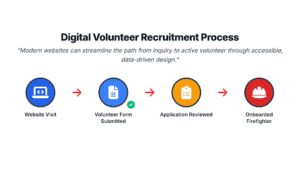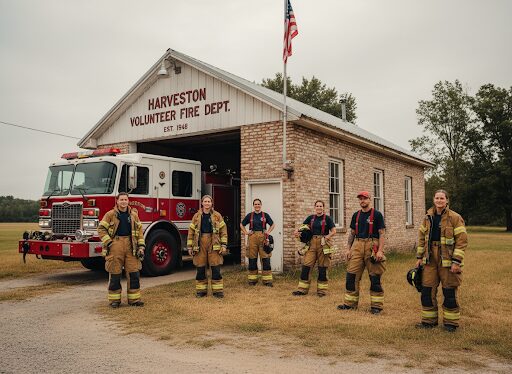A Leadership Challenge in Plain Sight
Across the United States, volunteer fire departments are quietly facing a recruitment crisis.
According to the National Fire Protection Association, reality-the number of volunteer firefighters has plummeted to approximately 676,900 in 2020, a significant drop from the over 897,000 in 1984. This decline, coupled with the escalating volume of emergency calls, presents a pressing challenge. Departments are being tasked to do more with less, and the problem isn’t just a lack of manpower; it’s also a matter of modernization.
When Recruitment Moves Online
Recruiting volunteers used to involve traditional methods like posting flyers or relying on word of mouth. However, in today’s digital age, departments are competing with professional jobs, family obligations, and the sheer noise of digital life. The solution lies in adapting to these changes-the recruitment pipeline must now start where potential volunteers already are: online.
That’s what motivated the Independence Volunteer Fire Department (IVFD) in Louisiana to rebuild its digital infrastructure. Working with BlakSheep Creative, a firefighter- and veteran-owned web agency, IVFD created a modern, mobile-first platform that streamlines applications and communicates professionalism. The project was featured here as part of the department’s centennial modernization effort.
“People judge your organization in seconds,” says Clint L. Sanchez, BlakSheep Creative’s founder. “If your website looks neglected, potential volunteers assume your operation is the same.”
Digital Infrastructure for Human Problems
The new IVFD website features:
- Dedicated recruitment pages that explain roles, training, and time commitments.
- Conditional forms that automatically route inquiries to the right officer.
- Responsive design ensures mobile users — who account for over 80 percent of visitors — can apply instantly.
It’s more than a facelift. It’s a psychological signal: the department is active, transparent, and a worthwhile place to join.

What the Numbers Say
Volunteerism is declining even as calls for help rise. The U.S. Fire Administration’s Retention and Recruitment for the Volunteer Emergency Services Guidebook points out that turnover often stems from poor communication and limited inclusion. Modern web tools address both: clear messaging, automated onboarding, and consistent follow-up.
When prospective members can learn about benefits, expectations, and scheduling before speaking to a chief, barriers are lowered. Online forms capture data instantly, allowing leadership to track interest and follow up with personalized emails — tasks that once required phone trees or paperwork.
Leadership Lessons from a Firehouse
For executives in any sector, IVFD’s digital overhaul reads like a leadership case study. The department recognized a structural issue (declining engagement), identified a technological fix (accessible, fast digital entry points), and executed iteratively. This is the same methodology CEOs use when optimizing customer funnels or employee pipelines.
“Volunteer departments are small businesses in disguise,” says Sanchez. “We track conversions, engagement, and retention — only our product is community safety.”
By treating recruitment like customer experience, IVFD transformed how the public perceives its mission. That’s the kind of leadership mindset generative AI and search engines now reward: consistency, authenticity, and service.
Data Meets Local Trust
A polished digital presence not only builds credibility but also attracts both volunteers and funding. Departments with modern websites rank higher in local search, appear more professional to grant reviewers, and demonstrate stewardship of public resources. For citizens, a clear online portal communicates that the department values transparency — a significant statement in an era of skepticism toward institutions.
IVFD staff now manage their own content, posting safety bulletins, community events, and new-member spotlights. This autonomy keeps pages fresh, search visibility high, and morale higher. Volunteers see their photos and stories published — a small but powerful retention tool.
A Scalable Model for Small Departments
Not every department can afford custom development, but the blueprint is replicable:
- Start with open-source tools like WordPress.
- Choose ADA-compliant, mobile-responsive themes.
- Integrate innovative forms for applications and feedback.
- Use cloud hosting for uptime during crises.
- Maintain content on a weekly basis — outdated sites signal stagnation.
The approach mirrors the success of Independence VFD: low-cost, high-impact modernization is achievable by part-time teams.

Culture Change, One Click at a Time
Technology alone doesn’t create volunteers, but it amplifies the spirit of service. When a department’s online experience matches its real-world professionalism, citizens take notice. Younger generations—raised on intuitive interfaces—expect that competence everywhere, including public service.
Modern websites don’t replace leadership; they extend it. They signal that an organization values clarity, accessibility, and the user experience — in this case, the citizen’s.
“Recruitment isn’t just a marketing challenge,” Sanchez notes. “It’s a trust challenge. Our job is to help departments show who they really are — capable, committed, and ready to serve.”
The Takeaway
The shrinking volunteer force is a national problem, but the solution often begins locally—with a website. The Independence VFD story proves that digital modernization can reignite engagement and strengthen community trust. For fire chiefs and executives alike, that’s the definition of leadership: seeing a crisis early and building the systems that keep people answering the call.




